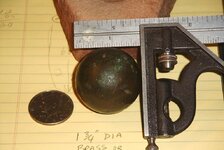M
mikusek
Guest
I found this in North Central Iowa on a slope just west of where an old farmstead used to be. At the time, there was still a pump standing. In the immediate area where I found this object, my Dad and I had found several small celts over the years, also several coins from the 1800's in the area where the house/yard probably was located.
This object is 1 3/4 inches diameter, it appears to be solid brass or bronze, it is heavy. I haven't weighed it. It has several dents. There are no makers marks or lettering. I have shown it to several archaeologists, no one could identify it with certainty, maybe I should have sought out a historical archaeologist.
One said he thought it was a ball for a small bore rifled cannon, the others had no idea. There are no rifling marks on it. He said he couldn't confirm his opinion.
John
Thanks to olroy70, TheCannonballGuy, & bigcypresshunter for the answer.
This object is 1 3/4 inches diameter, it appears to be solid brass or bronze, it is heavy. I haven't weighed it. It has several dents. There are no makers marks or lettering. I have shown it to several archaeologists, no one could identify it with certainty, maybe I should have sought out a historical archaeologist.
One said he thought it was a ball for a small bore rifled cannon, the others had no idea. There are no rifling marks on it. He said he couldn't confirm his opinion.
John
Thanks to olroy70, TheCannonballGuy, & bigcypresshunter for the answer.





 )
) 

